Are you thinking about visiting Joshua Tree National Park but aren’t sure what to expect when you want to go? Then this guide is for you.
I’m James and I’m a national park expert. In this guide, I’ll tell you what you can expect there during each month, so you can plan a trip that suits your needs. I describe the typical weather in Joshua Tree National Park each month, as well as park highlights, special events, permits, and more.
‼️ If you just want a quick snapshot of my thoughts on the best time to visit Joshua Tree National Park, check out my Best Time to Go to Joshua Tree National Park guide. ‼️
Subscribe to daily national parks planning tips, travel inspiration and trip ideas and get instant access to the free PDF of this guide to
Visiting Joshua Tree National Park Throughout The Year
No time right now to discover what to expect each month when visiting Joshua Tree National Park? Pin It and save it for later:
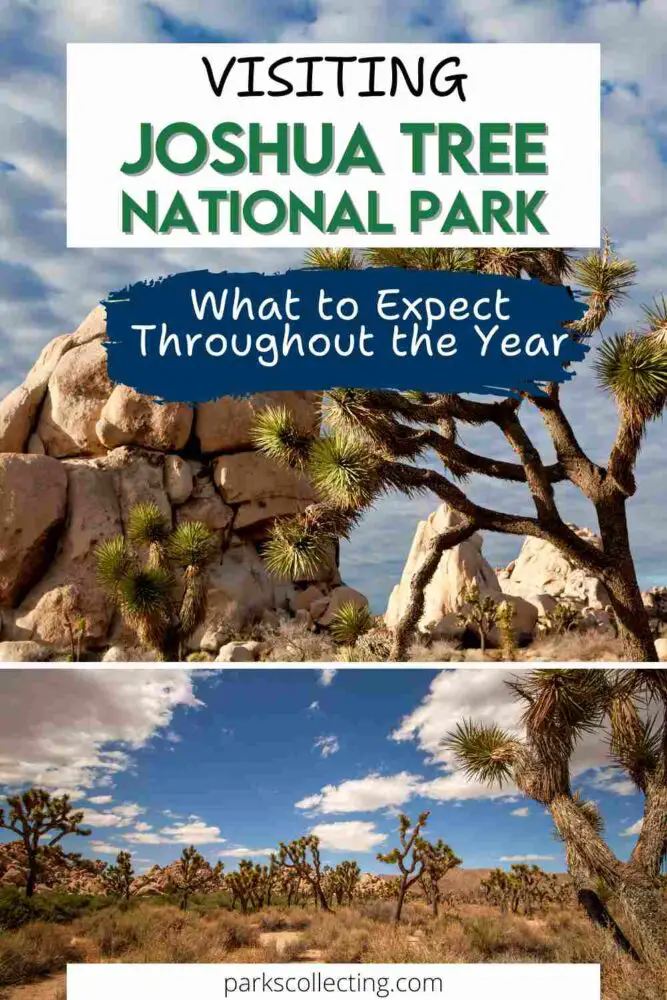
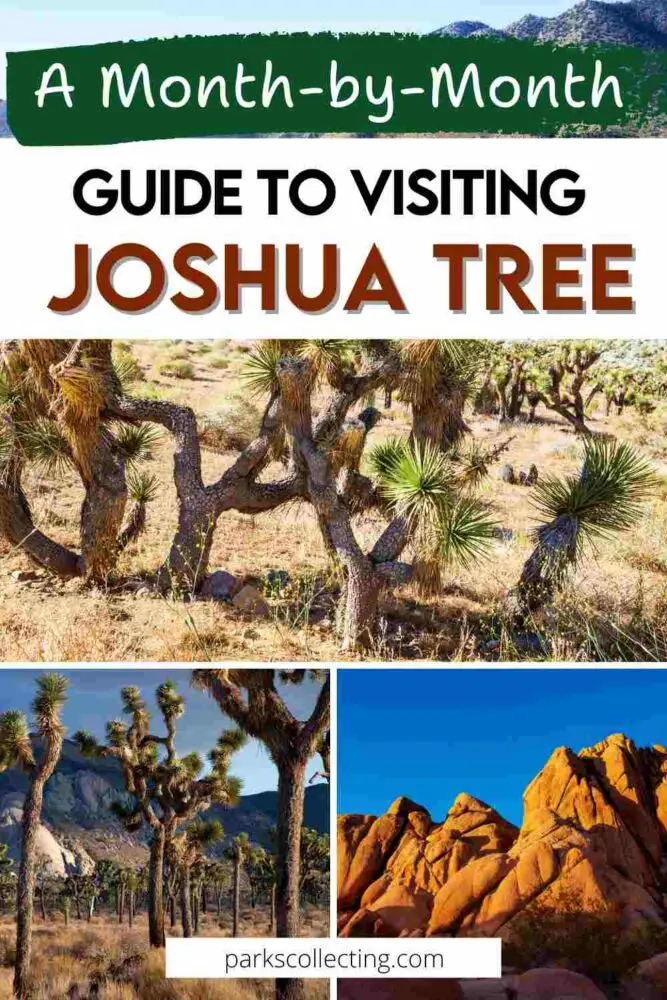
🛏️TOP HOTEL PICK: Check availability now
🚘FIND THE CHEAPEST CAR RENTAL: Search Discover Cars for the best deals
✈️FIND THE CHEAPEST FLIGHTS: Search Skyscanner for the best deals
🧳GET TRAVEL INSURANCE: Get insured with Travelex before you go
📱TAKE AN AUDIO TOUR: Buy an audio tour now
Table of Contents
Joshua Tree National Park in Spring (April – May)
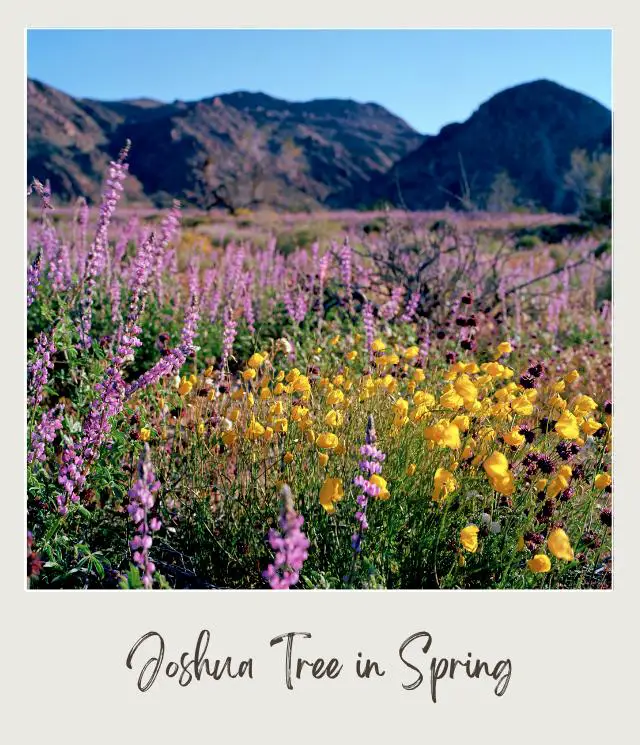
Spring takes place at Joshua Tree National Park during April and May. This is a very popular time to visit the park, with many wildflowers in full bloom and generally no rain.
Visiting Joshua Tree in April
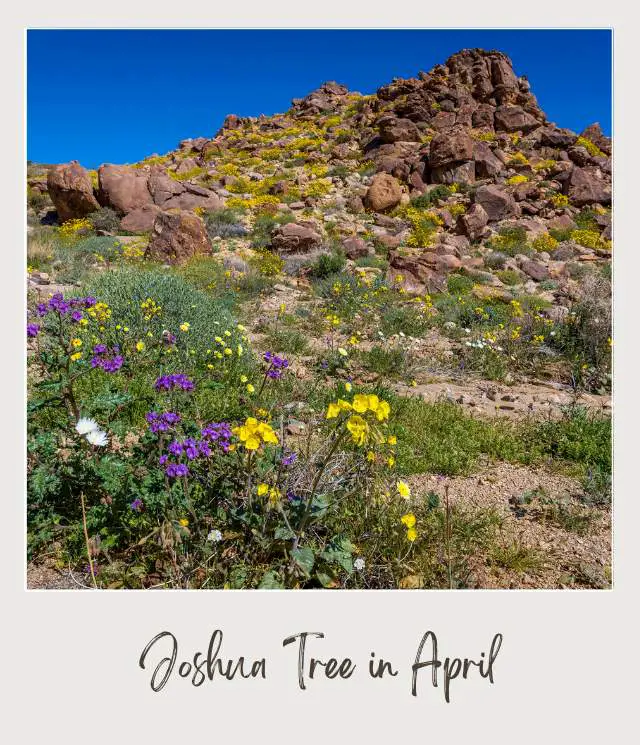
As you might expect from a desert location, the Joshua Tree weather in April is warm and dry. You can expect little to no rain at Joshua Tree National Park in April, as on average there are no days of rainfall during the first month of spring.
So how’s the Joshua Tree National Park weather in April in terms of temperature? You can expect highs of up to 81°F (27°C) on average. At the other end of the scale, the coldest temperature you might experience is around 48°F (9°C). So it’s warm, but not yet too hot.
This makes April a good month for hiking at Joshua Tree. You can also expect to see spring wildflowers blooming at this time of the year. Along with fall, temperatures are at their most comfortable at Joshua Tree during April and May.
Due to the clement weather, though, Joshua Tree is also at its busiest during April and May.
Pros
- Warm and dry weather
- Spring wildflowers are in bloom
- Comfortable hiking temperatures
Cons
- It can get cold overnight
- April is a popular and thus very busy month
Visiting Joshua Tree National Park in May
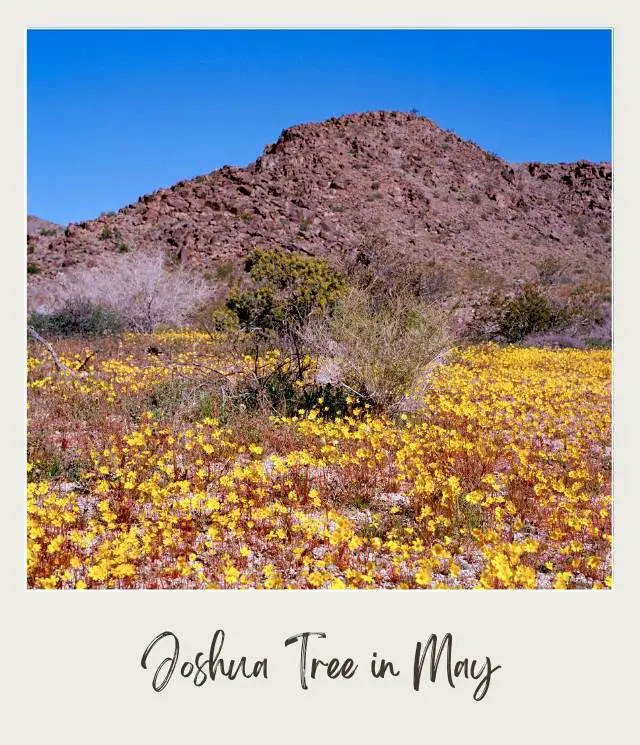
Temperatures at Joshua Tree in May are, on the whole, several degrees warmer than in April. This is also one of the driest months, with no rainfall at all expected during the average May.
Usual temperature ranges see lows of 55°F (13°C) and highs of 86°F (30°C). This is considerably cooler than the summer peak, when you can expect temperatures that are much higher.
Hiking conditions at Joshua Tree in May are therefore good, though those not used to hot weather might already like to avoid being out during the middle of the day. Set off early if you prefer cooler temperatures – and head for higher elevations to see wildflowers in May.
Due to these favorable conditions, the park has around twice as many visitors in spring as in summer. So while May is a great time to visit, do expect it to be busy. This means booking your accommodations well ahead of time.
Pros
- Dry, warm weather
- Spring wildflowers at higher elevations
- Not as extreme temperatures as in summer
Cons
- Visitors from cool climates may find it hot
- The park does get very busy in May
Joshua Tree National Park in Summer (June – August)
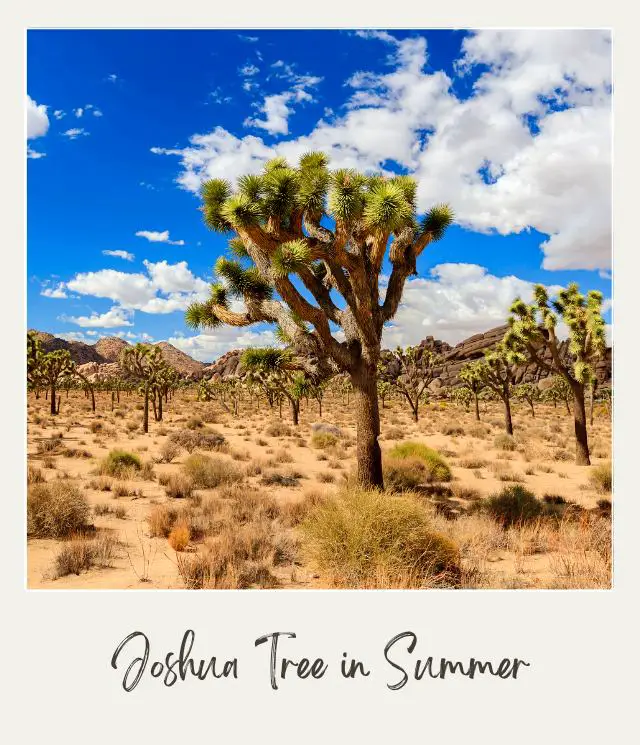
Joshua Tree in summer is a hot and dry place to be. June – and to a greater extent July and August – means hot weather. The desert conditions do limit what you can do here in summer, so think carefully before heading here at this time of the year.
Visiting Joshua Tree National Park in June
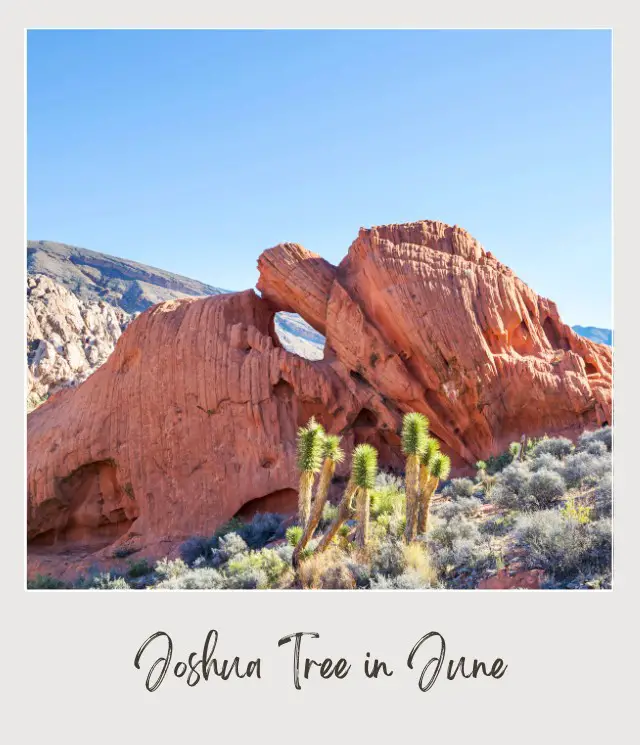
Joshua Tree National Park in June sees more comfortable highs than July and August temperatures, but it’s still getting pretty hot out there in early summer.
Lows are typically around 66°F (19°C), with highs of about 97°F (36°C). Again, you can expect no rainfall at all during the average June, so it’s unlikely that wet weather will affect your adventures.
If you do want to hike at Joshua Tree in June, then it’s wise to head out early in the day. By late morning, the weather can be too hot, especially for anyone who is used to cooler climes. This is the Californian desert, after all.
When you want to see wildflowers, you’ll need to head to higher elevations of 5,000 feet or more when visiting during June. By this time, the blooming season for the flowers at lower elevations will be over.
Pros
- Cooler than July and August
- Some wildflowers at higher elevations
Cons
- Midday temperatures can be uncomfortably high
- No wildflowers at elevations below 5,000 feet
Visiting Joshua Tree National Park in July
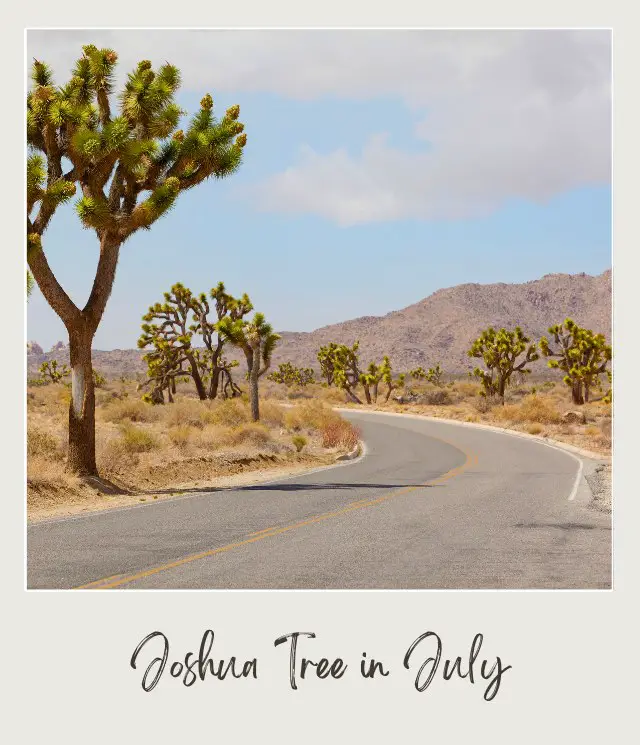
Head to Joshua Tree National Park in July and you’ll need to be prepared for very hot weather. This is the hottest month of the year, and you can also expect to experience no wet weather during July – though of course there can always be exceptions.
By July, the wildflower season is over and it’s very hot out there on the trails. Daytime highs can reach up to around 99°F (37°C), with the lowest temperatures you can expect being about 73°F (23°C).
Unless you’re accustomed to hiking in very high temperatures, this isn’t the best time to explore Joshua Tree on foot. By now the wildflowers will all have died off, too, even at the highest elevations.
Pros
- No rainy days during July
- The park isn’t so busy as in spring
Cons
- It’s too late for wildflowers
- Hiking can be very uncomfortable in the heat
Visiting Joshua Tree in August
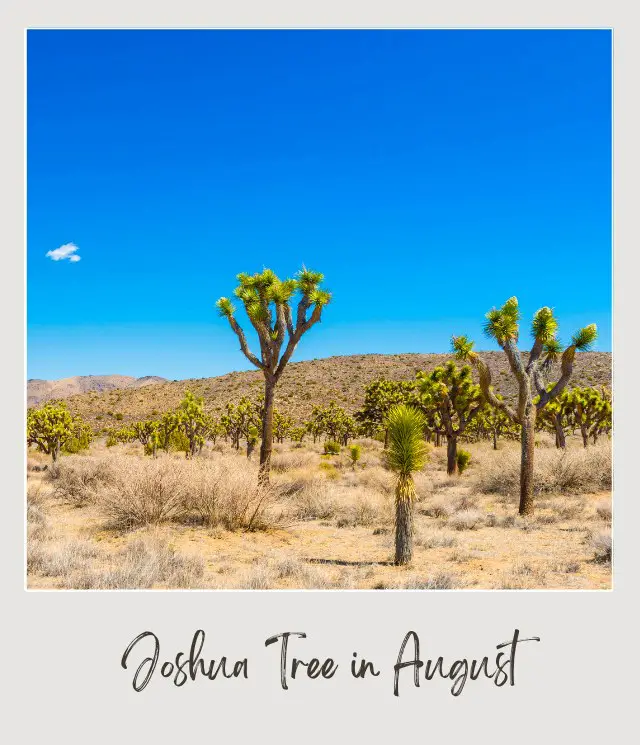
The weather at Joshua Tree National Park in August only differs ever so slightly from July. By this time of the year, it’s still very hot, but you can expect, on average, one day of rain in August.
Temperatures are much the same, with highs of about 99°F (37°C) and lows of around 72°F (22°C). By now the wildflower season has long gone, and the weather is still too hot for hiking – unless you’re used to such conditions (and can carry a lot of water).
As with July, the plus side is that the park can be quieter in summer. As more people head here in spring, visitor numbers in August can be around half of what they were during the park’s peak tourist season.
Pros
- It can be slightly cooler than July
- Lower visitor numbers than in spring
Cons
- No wildflowers
- One day of rain on average
- Too hot for most people to hike the trails
Joshua Tree National Park in Fall (September – November)
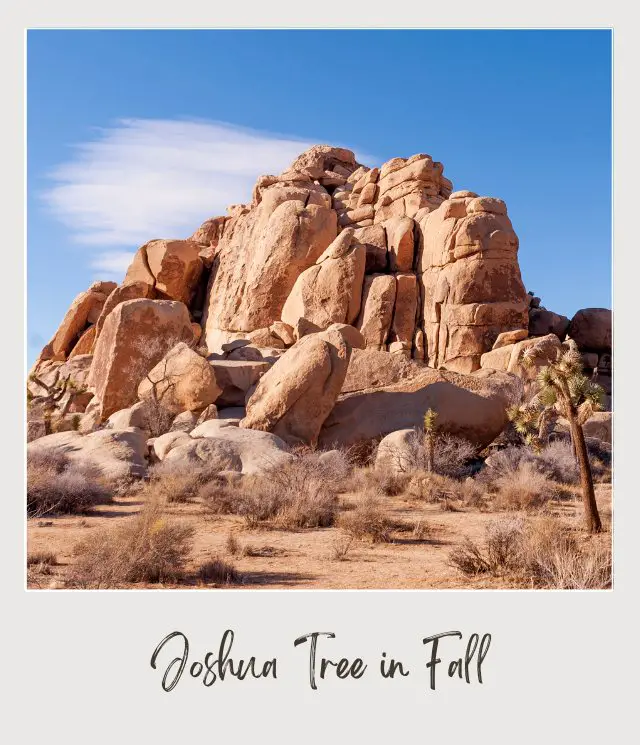
If you’re thinking of visiting Joshua Tree National Park in September onwards, then this can be one of the best times to visit. Do be aware that September can be almost as hot as summer, but by October and November you can expect both cooler temperatures and colorful fall foliage.
Visiting Joshua Tree in September
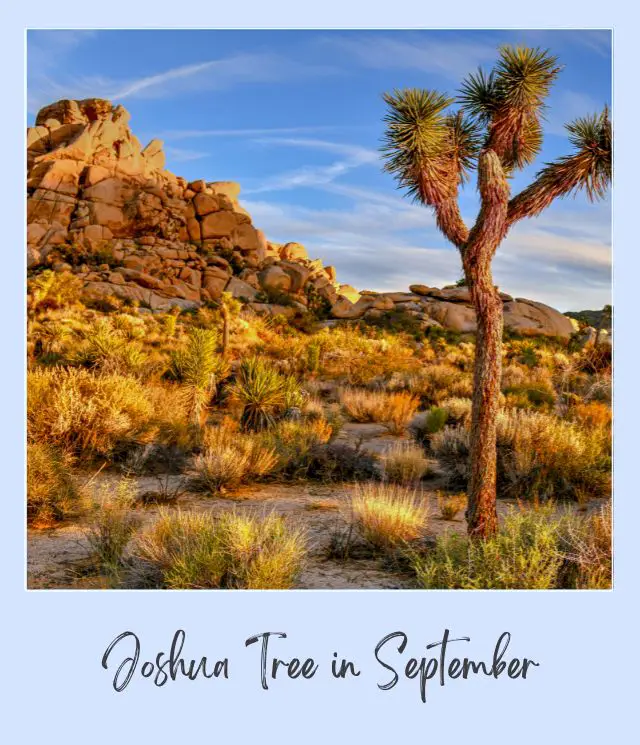
So how’s the Joshua Tree National Park weather in September? Does it begin to cool down significantly as compared to summer, and are temperatures comparable to what you’d experience during spring?
The weather in Joshua Tree in September is a fair few degrees hotter than what you’d find when visiting in May. At 93°F (34°C), daytime highs can still mean it’s uncomfortably hot during the middle of the day. Lows are around 64°F (18°C).
If you’re wondering what the Joshua Tree September weather holds in terms of rain, on average you can expect one wet day during the first month of fall.
In summary, the Joshua Tree weather in September is hot, but preferable to spending June, July and August in the Californian desert. Which means you may well get to see more of the park, especially if you set out hiking very early in the morning.
Pros
- Cooler than June, July, and August
- Better hiking conditions than in summer
Cons
- One rainy day is average
- Too early for fall colors – and too late for wildflowers
Visiting Joshua Tree in October
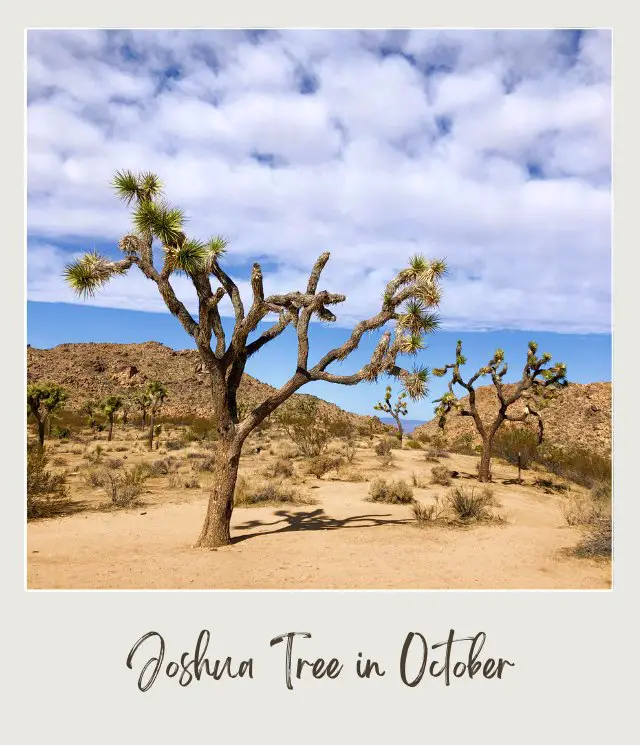
The Joshua Tree in October weather is comparable to that of May, so this is a comfortable time to visit the park. One advantage of heading here in fall instead of spring is that visitor numbers tend to be lower.
At Joshua Tree National Park in October, you can expect temperatures to range between lows of around 54°F (12°C). and highs of about 84°F (29°C). The Joshua Tree National Park weather in October tends to be dry, with no days of rain forecast as a rule.
During late October in particular, you may see some colorful fall leaves at Joshua Tree. Overall, this is a good month to pay the park a visit, with warm rather than hot temperatures, dry weather in general and fewer visitors than in spring.
Pros
- Little to no chance of rain
- Less visitors than in spring
- Pleasant daytime temperatures
Cons
- May be too early for fall leaves
- It’s not wildflower season
Visiting Joshua Tree in November
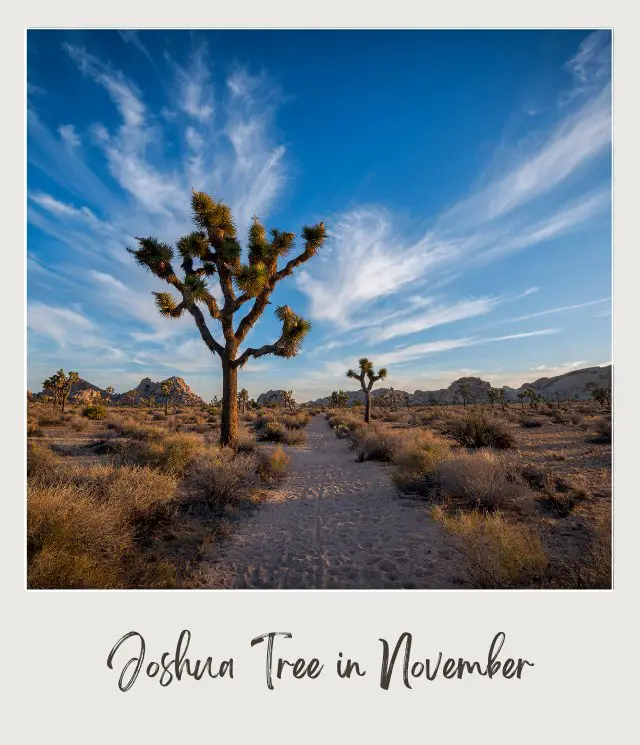
The Joshua Tree weather in November is most similar to that of March. If you like to hike in conditions that are cool, but not cold, then this could be the perfect month to head here. The Joshua Tree National Park weather in November does reflect the fact that it’s late in the year, though, so it can get chilly overnight.
At Joshua Tree National Park in November you can expect one day of rain on average. Temperatures range from lows of about 43°F (6°C) to highs of around 72°F (22°C). So it’s mild – and you may need to pack some layers for cooler mornings and evenings.
Again, the Joshua Tree in November weather is comparable to early spring, but there are fewer crowds in fall. By November, you also have a far better chance of seeing some spectacular fall colors than in the preceding month. You can also expect a good number of sunny days.
Pros
- Fall colors
- Cooler temperatures ideal for hiking
- The park is less busy than during the spring season
Cons
- It can get cold overnight
- This is generally a wetter month than October
Joshua Tree National Park in Winter (December – March)
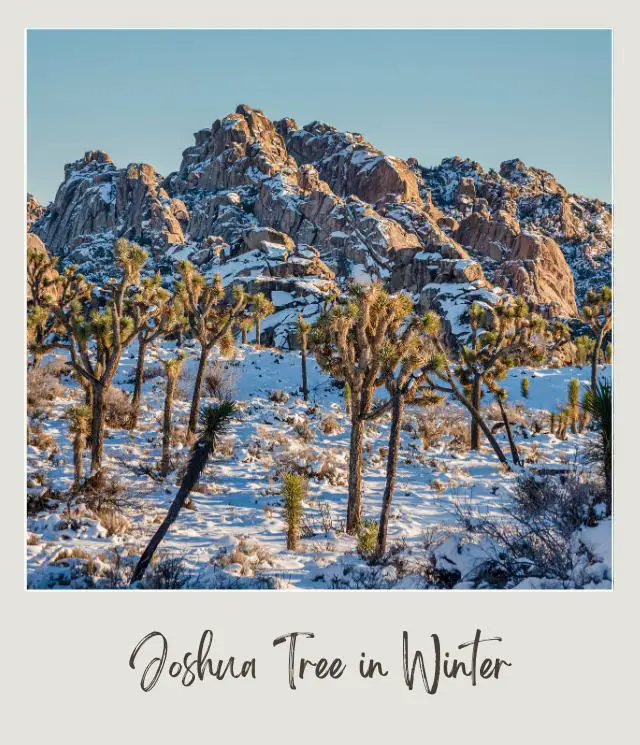
Head to Joshua Tree in winter and you can expect mild daytime temperatures coupled with colder nights. The Joshua Tree winter weather reflects the southern California location, so zero (celsius) temperatures are pretty much unheard of here.
Visiting Joshua Tree National Park in December
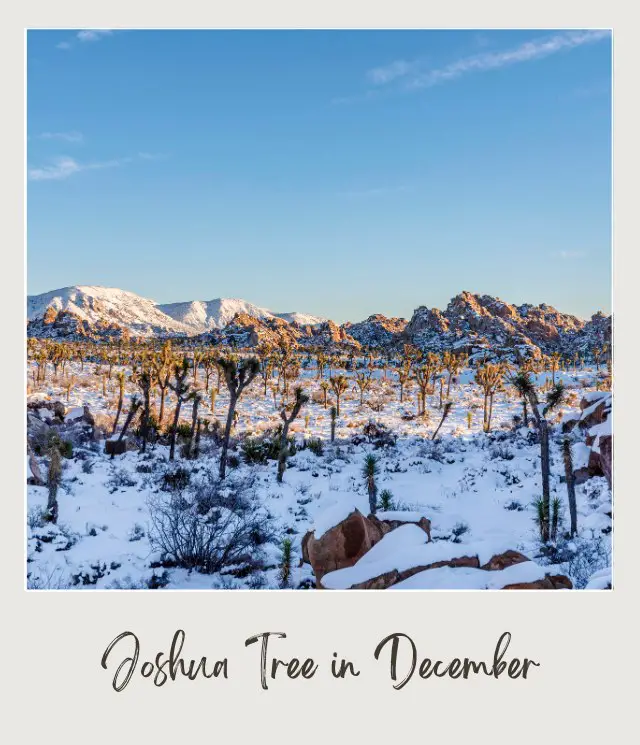
If the idea of visiting Joshua Tree National Park in the winter appeals, then what’s the Joshua Tree weather in December like? As the coldest month, the Joshua Tree National Park temperature in December is as chilly as it gets in the Californian desert.
Generally, the Joshua Tree National Park weather in December is dry, with one day of rainfall on average during the first month of winter. Temperature-wise, you’re looking at lows of around 37°F (3°C), with highs of about 61°F (16°C).
If you don’t mind cool weather, this can be a great time to explore the park. Though it can get busy around the holiday season, this is usually a quiet time of the year. When you want to camp, do make sure to bring a sleeping bag that’s designed to keep you warm in cold temperatures.
Pros
- Cool, comfortable hiking conditions
- Peaceful time to visit the park
Cons
- It can be very cold at night
- You can expect one day of rain
- The festive season can be busy
Visiting Joshua Tree in January
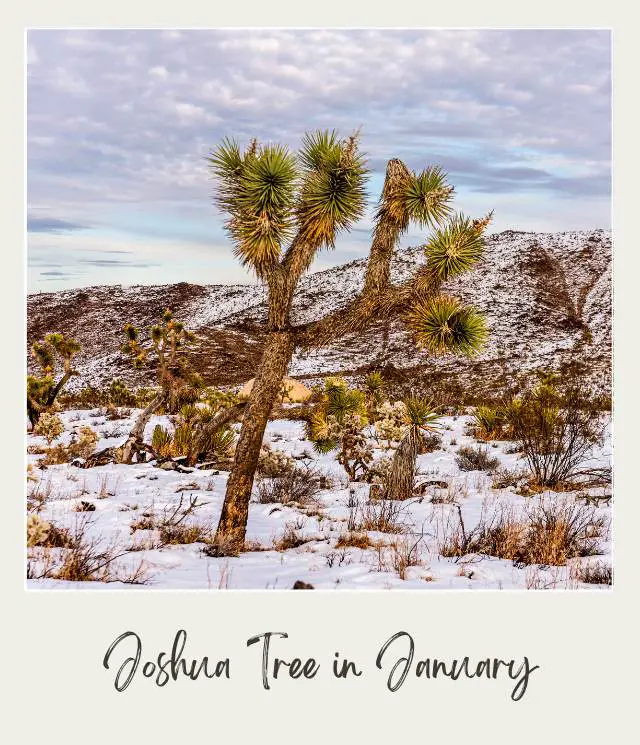
The average Joshua Tree National Park temperature in January is only marginally warmer than December. Similar highs and lows can be expected. The weather at Joshua Tree National Park in January is generally the wettest it gets all year: this is the only month when you can expect two – rather than one or no – days of rain.
If you look at the Joshua Tree temperature by month, it’s clear to see that January and December are the coldest months. Low temperatures are around 37°F (3°C), with highs of about 63°F (17°C).
When you don’t mind the fact that the Joshua Tree in January weather is on the cool side, this can be a good time to visit. Once the festive season has passed it’s quiet, and is less busy than the popular spring – and to a lesser extent – fall periods.
Pros
- Cool temperatures for hiking
- The park is very quiet after New Year
- Some wildflowers may be in bloom later in the month
Cons
- January is the wettest month on average
- Expect chilly January nights
Visiting Joshua Tree in February
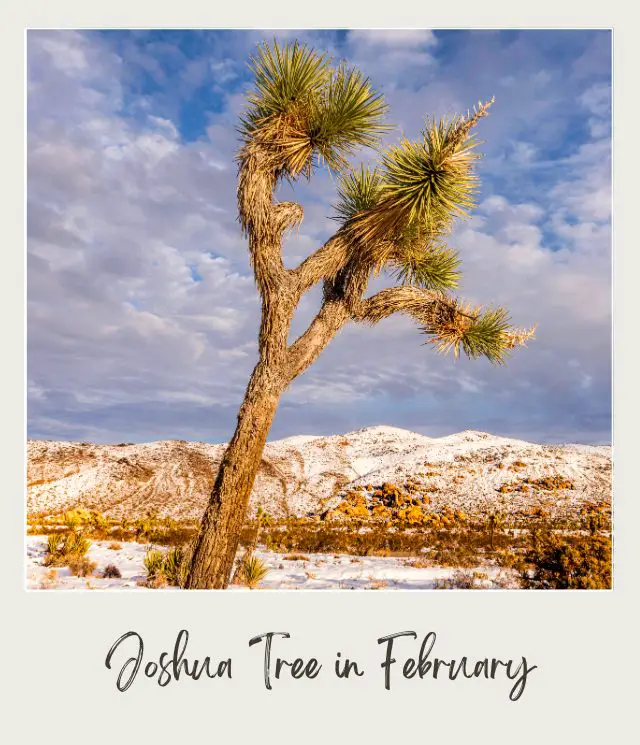
The Joshua Tree weather in February brings slightly milder temperatures than those typical of December and January. You also have a good chance of seeing some wildflowers at Joshua Tree National Park in February, as these can begin to bloom as early as January.
The Joshua Tree National Park weather in February brings low temperatures of about 37°F (3°C), with highs reaching up to around 66°F (19°C). This is comparable to late November or early December. One day of rain is average for the month of February.
If you visit Joshua Tree in February, the weather is pleasantly cool for hiking, though it can still get pretty cold at night. At lower elevations, you can see some wildflowers already blooming now too, some time before spring really begins in April.
Pros
- The park can be very peaceful
- Warmer than December and January
- Wildflowers will be blooming at lower elevations
Cons
- It can still be very cold overnight
- The chance of rain is higher than from March onwards
Visiting Joshua Tree in March
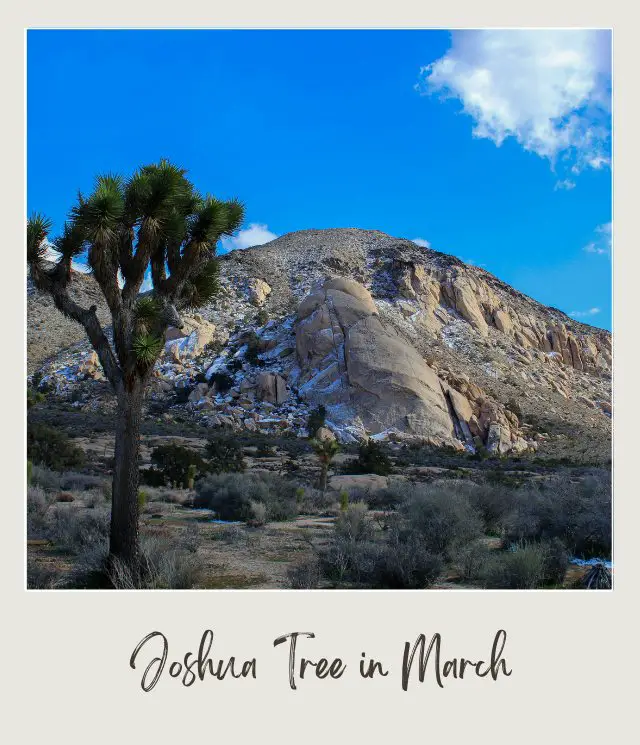
Think about heading to Joshua Tree National Park in March if you want fairly mild weather and fewer crowds. There’s also more places to see wildflowers due to the warmer Joshua Tree National Park weather in March, as they will be in bloom at elevations of up to 5,000 feet.
More good news comes from the fact that the Joshua Tree March weather tends to be dry, with no days of rain on average. Temperatures are starting to creep up a bit, and highs can reach up to 73°F (23°C). At night, do expect the mercury to dip as low as 43°F (6°C), though.
For wildflowers, mild days and dry weather, March is a good time to head to Joshua Tree. But if you prefer warmer temperatures, you might like to wait until April or May, or to head here in the fall months of September or October.
Pros
- Temperatures are warming up
- It’s not as busy as in April and May
- You can see wildflowers at elevations up to 5,000 feet
Cons
- Overnight chills are still the norm
- The Easter period can be busy, if this falls in March
Travel Insurance for Joshua Tree National Park
No matter when you go to Joshua Tree National Park, you should definitely get travel insurance. This can protect you not only against medical and emergency repatriation, but can also cover things like trip cancellation, loss and/ or theft of property, etc.
➡️ A great insurance option is Travelex. It has coverage for all you’ll need. You can compare Travel Insurance plans here or get a quote right now:
Enjoy Joshua Tree National Park!
More Planning Resources for Joshua Tree National Park
⭐ Joshua Tree National Park Guide
⭐ Planning A Trip to Joshua Tree National Park: 7 Mistakes to Avoid
⭐ The 10 Best Hikes in Joshua Tree National Park
⭐ How to Get to Joshua Tree National Park
⭐ All The Airports Near Joshua Tree National Park
⭐ What Is The Closest Airport To Joshua Tree National Park?
⭐ Best Time To Visit Joshua Tree National Park
⭐ 10 Tips For Visiting Joshua Tree National Park
⭐ 10 Fun Facts about Joshua Tree National Park
⭐ The 20 Best Vacation Rentals in Joshua Tree
What do you think is the best time of day to visit Joshua Tree National Park? Join my private Facebook group National Parks Collectors and comment and let me know (you can also pick up extra planning tips, share your photos and stories with other national park lovers and more).
Subscribe to daily national parks planning tips, travel inspiration and trip ideas and get instant access to the free PDF of this guide to
Visiting Joshua Tree National Park Throughout The Year
If you liked this article about the best time to go to Joshua Tree National Park, Pin It to your Joshua Tree National Park board!


💡 Are you just starting to think about taking a national parks trip? Get Inspiration
‼️ Are you looking for helpful tips for visiting US national parks? Read articles that share useful tips on a range of national-park related issues
💻 Are you starting to plan a trip to Joshua Tree National Park? Read my Guide to Joshua Tree National Park
🛏️ Are you looking for a place to stay near Joshua Tree National Park? Find a vacation rental near Joshua Tree National Park
💲 Are you ready to book your trip? Use these Planning and Booking Resources
📖 Do you want to read a book about US national parks? Check out my Recommended Reading Lists
About the Author

James Ian is a national park, camping and hiking expert.
He has dedicated his life to travel, visiting more than 80 countries, all 7 continents and most of the national parks in the United States. With over 35 years experience in the travel industry, James has worked on cruise ships, at resorts and hotels, and as a travel planner who’s helped hundreds of people plan successful trips to US national parks.
Based on his experience visiting our national parks multiple times, in-depth research and expertise as a travel planner, James has published detailed itineraries for many of the major national parks in the US. These itineraries, as well as in-depth park guides, and other resources will help you have your own incredible trip to US national parks without stress and hassle.
As a national park expert, James has contributed to many publications, including USA Today, Newsweek, Time Business News, Savoteur, Best Trip, and Wired.
I’m a member of the Amazon Services LLC Associates Program. As an Amazon Associate I earn from qualifying purchases.
